For the 2025 school year, there are 2 public preschools serving 764 students in Edison Local School District. This district's average pre testing ranking is 5/10, which is in the bottom 50% of public pre schools in Ohio.
Public Preschools in Edison Local School District have an average math proficiency score of 64% (versus the Ohio public pre school average of 48%), and reading proficiency score of 67% (versus the 53% statewide average).
Minority enrollment is 5% of the student body (majority Hispanic), which is less than the Ohio public preschool average of 39% (majority Black).
Overview
This School District
This State (OH)
# Schools
4 Schools
839 Schools
# Students
1,379 Students
334,112 Students
# Teachers
68 Teachers
18,897 Teachers
Student : Teacher Ratio
20:1
20:1
District Rank
Edison Local School District, which is ranked within the top 50% of all 918 school districts in Ohio (based off of combined math and reading proficiency testing data) for the 2021-2022 school year.
The school district's graduation rate of 85-89% has decreased from 90-94% over five school years.
Overall District Rank
#386 out of 929 school districts
(Top 50%)
(Top 50%)
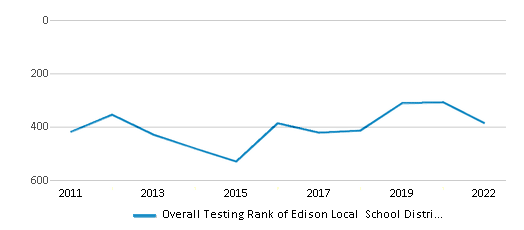
Math Test Scores (% Proficient)
51%
52%
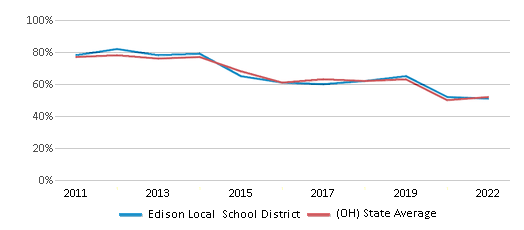
Reading/Language Arts Test Scores (% Proficient)
64%
60%
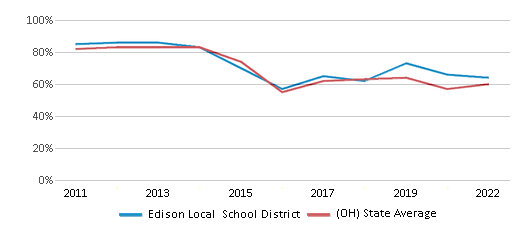
Science Test Scores (% Proficient)
62%
63%

Graduation Rate
85-89%
86%
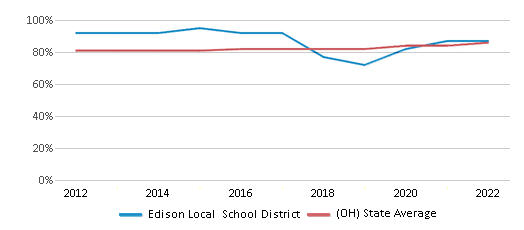
Students by Ethnicity:
Diversity Score
0.09
0.58
# American Indian Students
n/a
462 Students
% American Indian Students
n/a
n/a
# Asian Students
1 Student
8,061 Students
% Asian Students
n/a
3%
# Hispanic Students
18 Students
30,384 Students
% Hispanic Students
1%
9%
# Black Students
3 Students
67,190 Students
% Black Students
n/a
20%
# White Students
1,317 Students
204,949 Students
% White Students
96%
61%
# Hawaiian Students
n/a
329 Students
% Hawaiian Students
n/a
n/a
# Two or more races Students
40 Students
22,737 Students
% of Two or more races Students
3%
7%
Students by Grade:
# Students in PK Grade:
118
45,802
# Students in K Grade:
79
55,948
# Students in 1st Grade:
96
51,388
# Students in 2nd Grade:
90
49,073
# Students in 3rd Grade:
94
40,515
# Students in 4th Grade:
87
38,905
# Students in 5th Grade:
91
30,860
# Students in 6th Grade:
109
12,193
# Students in 7th Grade:
111
4,329
# Students in 8th Grade:
104
4,221
# Students in 9th Grade:
108
368
# Students in 10th Grade:
144
211
# Students in 11th Grade:
67
188
# Students in 12th Grade:
81
111
# Ungraded Students:
-
-
District Revenue and Spending
The revenue/student of $20,637 is higher than the state median of $17,287. The school district revenue/student has stayed relatively flat over four school years.
The school district's spending/student of $22,476 is higher than the state median of $17,235. The school district spending/student has stayed relatively flat over four school years.
Total Revenue
$29 MM
$28,879 MM
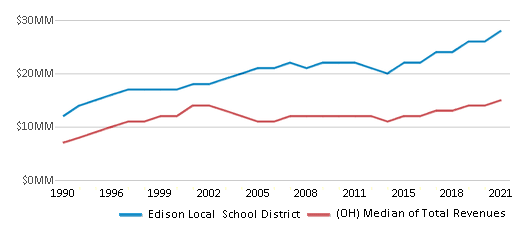
Spending
$31 MM
$28,792 MM
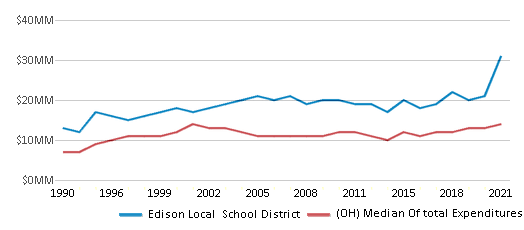
Revenue / Student
$20,637
$17,287
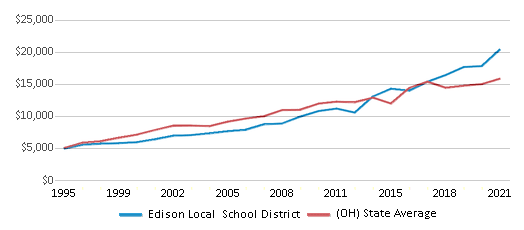
Spending / Student
$22,476
$17,235
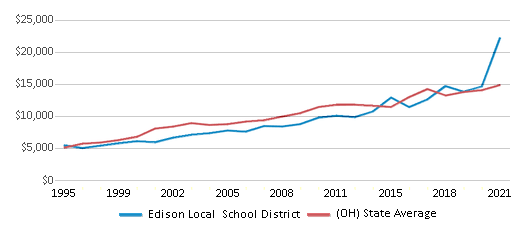
Best Edison Local School District Public Preschools (2025)
School
(Math and Reading Proficiency)
(Math and Reading Proficiency)
Location
Grades
Students
Rank: #11.
John E Gregg Elementary School
(Math: 70-74% | Reading: 75-79%)
Rank:
Rank:
9/
Top 20%10
212 County Road 75a
Bergholz, OH 43908
(740) 768-2100
Bergholz, OH 43908
(740) 768-2100
Grades: PK-6
| 372 students
Rank: #22.
Stanton Elementary School
(Math: 55-59% | Reading: 55-59%)
Rank:
Rank:
6/
Top 50%10
14890 State Route 213
Hammondsville, OH 43930
(330) 532-1594
Hammondsville, OH 43930
(330) 532-1594
Grades: PK-6
| 392 students
Recent Articles

Year-Round Or Traditional Schedule?
Which is more appropriate for your child? A year-round attendance schedule or traditional schedule? We look at the pros and cons.

Why You Should Encourage Your Child to Join a Sports Team
Participating in team sports has a great many benefits for children, there is no doubt. In this article you will learn what those benefits are.

White Students are Now the Minority in U.S. Public Schools
Increasing birth rates among immigrant families from Asia and Central and South America, combined with lower birth rates among white families, means that for the first time in history, public school students in the United States are majority-minority. This shift in demographics poses difficulties for schools as they work to accommodate children of varying language abilities and socio-economic backgrounds.





